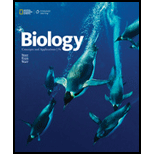
Organic molecules consist mainly of _______ atoms.
| a. carbon | c. carbon and hydrogen |
| b. carbon and oxygen | d. carbon and nitrogen |
Introduction:
Organic molecules are referred to the molecules of life. These organic molecules are made up of carbon atoms. Carbohydrates, lipids, nucleic acids and proteins are four different types of organic molecules.
Answer to Problem 1SQ
Correct answer:
Organic compounds are those compounds which are mainly made up of carbon and hydrogen atoms. Hence, the correct answer is option c.
Explanation of Solution
Reason for correct answer:
Option c. is given as “carbon and hydrogen.”
Carbon atoms can assemble to form different types of compounds because of their versatility. The compounds which are mainly made up of carbon and hydrogen atoms are known as hydrocarbons, and these are said to be organic.
Reason for incorrect answer:
Option a. is given as, “carbon.”
Organic compounds are made up of mainly hydrogen and carbon atoms. Carbon can bond with another carbon molecules, but hydrogen is the main partner of carbon atom in organic compounds. Hence, option a. is incorrect.
Option b. is given as, “carbon and oxygen.”
Carbon and oxygen atoms can bond with each other to form organic compounds, but the atom which is mainly involved in organic compounds is hydrogen. Hence, option b. is incorrect.
Option d. is given as, “carbon and nitrogen.”
Carbon and nitrogen form different types of organic compounds such as proteins. The nitrogen atom is not mainly involved to make organic molecules. Hence, option d. is incorrect.
Hence, the options a., b., and d. are incorrect.
Therefore, organic molecules consist mainly of carbon and hydrogen atoms. Thus, the correct answer is option c.
Want to see more full solutions like this?
Chapter 3 Solutions
Biology: Concepts and Applications (MindTap Course List)
- Outline the negative feedback loop that allows us to maintain a healthy water concentration in our blood. You may use diagram if you wisharrow_forwardGive examples of fat soluble and non-fat soluble hormonesarrow_forwardJust click view full document and register so you can see the whole document. how do i access this. following from the previous question; https://www.bartleby.com/questions-and-answers/hi-hi-with-this-unit-assessment-psy4406-tp4-report-assessment-material-case-stydu-ms-alecia-moore.-o/5e09906a-5101-4297-a8f7-49449b0bb5a7. on Google this image comes up and i have signed/ payed for the service and unable to access the full document. are you able to copy and past to this response. please see the screenshot from google page. unfortunality its not allowing me attch the image can you please show me the mathmetic calculation/ workout for the reult sectionarrow_forward
- Skryf n kortkuns van die Egyptians pyramids vertel ñ story. Maximum 500 woordearrow_forward1.)What cross will result in half homozygous dominant offspring and half heterozygous offspring? 2.) What cross will result in all heterozygous offspring?arrow_forward1.Steroids like testosterone and estrogen are nonpolar and large (~18 carbons). Steroids diffuse through membranes without transporters. Compare and contrast the remaining substances and circle the three substances that can diffuse through a membrane the fastest, without a transporter. Put a square around the other substance that can also diffuse through a membrane (1000x slower but also without a transporter). Molecule Steroid H+ CO₂ Glucose (C6H12O6) H₂O Na+ N₂ Size (Small/Big) Big Nonpolar/Polar/ Nonpolar lonizedarrow_forward
- what are the answer from the bookarrow_forwardwhat is lung cancer why plants removes liquid water intead water vapoursarrow_forward*Example 2: Tracing the path of an autosomal dominant trait Trait: Neurofibromatosis Forms of the trait: The dominant form is neurofibromatosis, caused by the production of an abnormal form of the protein neurofibromin. Affected individuals show spots of abnormal skin pigmentation and non-cancerous tumors that can interfere with the nervous system and cause blindness. Some tumors can convert to a cancerous form. i The recessive form is a normal protein - in other words, no neurofibromatosis.moovi A typical pedigree for a family that carries neurofibromatosis is shown below. Note that carriers are not indicated with half-colored shapes in this chart. Use the letter "N" to indicate the dominant neurofibromatosis allele, and the letter "n" for the normal allele. Nn nn nn 2 nn Nn A 3 N-arrow_forward
 Concepts of BiologyBiologyISBN:9781938168116Author:Samantha Fowler, Rebecca Roush, James WisePublisher:OpenStax College
Concepts of BiologyBiologyISBN:9781938168116Author:Samantha Fowler, Rebecca Roush, James WisePublisher:OpenStax College
 Human Biology (MindTap Course List)BiologyISBN:9781305112100Author:Cecie Starr, Beverly McMillanPublisher:Cengage Learning
Human Biology (MindTap Course List)BiologyISBN:9781305112100Author:Cecie Starr, Beverly McMillanPublisher:Cengage Learning Biology (MindTap Course List)BiologyISBN:9781337392938Author:Eldra Solomon, Charles Martin, Diana W. Martin, Linda R. BergPublisher:Cengage Learning
Biology (MindTap Course List)BiologyISBN:9781337392938Author:Eldra Solomon, Charles Martin, Diana W. Martin, Linda R. BergPublisher:Cengage Learning Biology: The Unity and Diversity of Life (MindTap...BiologyISBN:9781337408332Author:Cecie Starr, Ralph Taggart, Christine Evers, Lisa StarrPublisher:Cengage Learning
Biology: The Unity and Diversity of Life (MindTap...BiologyISBN:9781337408332Author:Cecie Starr, Ralph Taggart, Christine Evers, Lisa StarrPublisher:Cengage Learning





